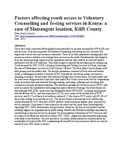| dc.description.abstract | There have been concerted efforts globally and nationally to increase demand for HIV/AIDS care and services. of no less important is Voluntary Counseling and testing service, because this begins the critical care and treatment continsum. There is no other population demographic that present as much a problem in accessing these services as the youth. Paradoxically, this happens to be the fastest growing segment of the population and one that exhibits several risk factors associated with the HIV infection. This study sought to identify factors that may be influencing Youth demand for HIV I AIDS voluntary Counseling and Testing Services in Kenya, studying the case of Matsangoni Location in Kilifi County.
Method:
This descriptive survey design used both primary and secondary data. The sample population consisted of both male and female youth in Matsangoni location. A sample of 301 respondents was drawn using convenience sampling technique. Primary data was obtained through direct observation, key informants, and the interviews using structured open and close ended face to face interviews with the respondents while secondary data was obtained through reading, analyzing, collating and recording data contained in already prepared materials. The statistical package for Social Sciences (SPSS) was used to analyze the quantitative data using descriptive statistics
Findings
The study found out that although 94% of the youth were knowledgeable about HIV/AIDS, including transmission and risk factors (81%), and that majorities (45.5%) were aware of the availability of VCT services, and 82.2% of them lived within a radius of 1.5 km from a VCT center, only 85.4% of them were willing to access this service. The factors found in this sample to be influencing youths demand forVCT were fear of HIV positive result and social stigma, poor reception by service provider.
Conclusion
It was evident in the study that the youth were knowledgeable regarding HIV / AIDS transmission and prevention. However, the fear to test positive and the resulting stigma, are impediments to youth testing. Health care Provider's attitudes may also be contributing to this lack of service demand.
Recommendation
Utilization of VC'T services will be enhanced if efforts are directed to reduce HIV / AIDS , stigma and discrimination beginning with those at the frontline - the care providers. Secondly, youths should be educated about the availability of treatment for HIV, emphasizing the benefits of early treatment which can only be started if one's HIV status is known. | en_US |

